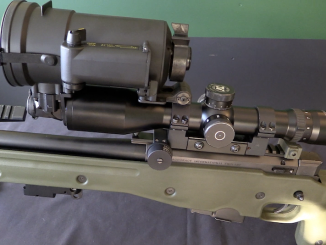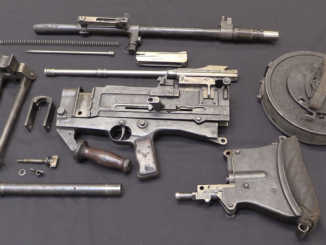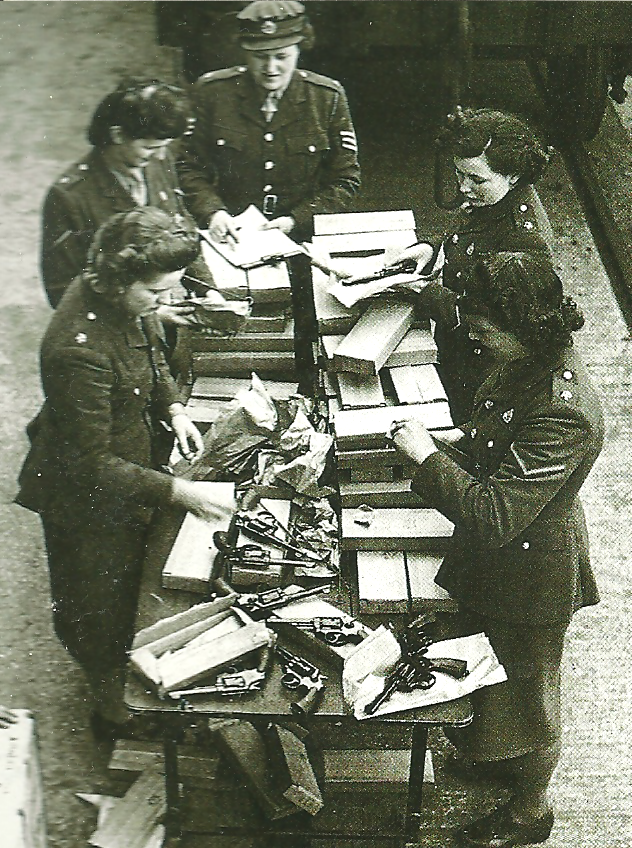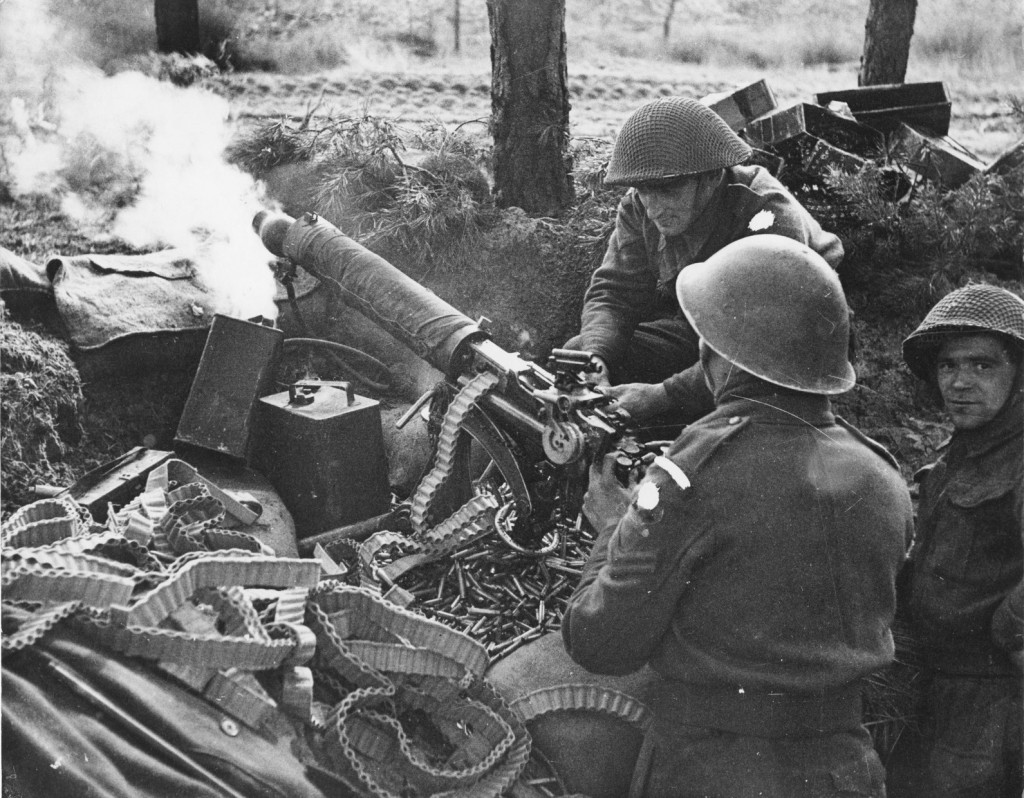British troops in the Netherlands (Overloon, specifically) using a Vickers for indirect fire. In addition to the copious empty brass, belts, ammo boxes, and spare condensing can, note the angle of the dial sight relative to the gun…
Related Articles

Bolt Action Rifles
L118A2: Accuracy International Arctic Warfare
After the British adoption of the Accuracy International PM as the L96A1 sniper rifle, other nations began to give a very serious look at the company and its rifles. One of the first was Sweden, […]

Conversion
From Aircraft to Improvised Infantry: the Vickers MkI No2
The Vickers MkI No2 was an improvisation of the British Royal Air Force. They needed arms for airbase defense, without unduly impacting the production of weapons for the infantry. Wheat they had a good supply […]

Revolver
Vintage Saturday: Send a Gun to Defend a British Home!
“When the ships from America approached our shores with their priceless arms special trains were waiting in all the ports to receive their cargoes,” Churchill recalled. “The Home Guard in every county, in every town, […]


Very interesting pictures and articles
The eternal problem of the British Army until 1950.
They used machine guns as artillery.
Ian Hogg has a concise and clear explanation of the actual ballistic concept ( First Catch, First Graze, Beaten Zone, Dangerous Space, etc. ) behind proper battlefield usage of the machine gun on Pages 65-68 of his book, “Machine Guns”. There is also a paragraph on Page 54 that briefly describes use of the Vickers 0.303″ MMG in the indirect fire role, along with a good photograph of a Vickers gun equipped with a panoramic collimating sight designed specifically for that purpose.
While I agree with Dimitris that using machine guns in the indirect fire role is not a substitute for artillery, this methodology still has its uses on the battlefield and can catch an enemy by surprise, inflicting psychological trauma and physical casualties as well as restricting his mobility and movements even if he is in defilade.
BTW, the dial sight in the photograph above is of the same type as the collimating sight on Page 54 of Hogg’s “Machine Guns”.
Hai, Earl
When in 1942 the allies began to suplay weapons to the Greek rebels of ELAS and EDES, the British were very sparing in granting Vikers machine guns because their philosophy was that heavy machine guns are only for indirect fire, something like artillery. After the liberation in 1944, the British supplied with military materiel the Hellenic Royal Army during the first phase of the Civil War ( 1946-1948) and again refused to grant Vickers machine guns, insisting their theories on indirect firing. In 1946 the Royal Army had only 36 Vikers and in 1948 64 Vikers.In 1947 the Americans came and everything changed.
Dimitris, thanks for the interesting historical information on the deployment of the Vickers MMG in Greek service. The British insistence on the indirect fire role was probably in keeping with the changes in tactical doctrine and re-organization of 1914 when all Vickers guns, previously allotted two to an infantry battalion, were withdrawn entirely from those battalions and grouped into batteries within a new regiment, the Machine Gun Corps. The idea was to enable the Vickers, with their full sustained-fire capability, to provide heavy automatic fire support as needed while the infantry relied on the lighter and more portable Lewis gun for tactical battlefield use. This make-over in the TO & E of the British Army had its roots in the decade leading up to the First World War, when tacticians in the more prominent European armies gradually began to realize that the light machine gun — previously relegated to the cavalry — was almost ideal for the assault infantry in mobile warfare, whereas the heavy, water-cooled MG with its more extensive logistical needs and much greater firepower was best put to use in the support role.
I also wonder if the steadfast refusal to supply more Vickers guns to the Hellenic Army on the grounds of the indirect fire role was also a cover for a deeper political agenda, given the social and political climate of the time?
The “indirect fire” explanation concerning the numbers of Vickers MGs supplied to Greece seems highly unlikely. Why would indirect fire doctrine cause the British to limit the number? It doesn’t make any sense.
Instead, the British supplied them according to the British’s own existing ‘light infantry’ standard TO&E. Each Hellenic battalion was equipped with about 300-500 men armed with Lee-Enfield rifles, 36 Bren LMG, 4 81mm mortars (for indirect fire of course) and 4 Vickers HMG. Just like a British battalion.
60 Vickers on inventory would equip quite a few Hellenic battalions. It had nothing to do with indirect fire, nor were the British “sparing” of their supply of them.
Also, the Vickers and its ammo is a very heavy load requiring at least 3 strong men per gun, while the much lighter Bren LMG and its lighter ammo would only require 2 men. An important consideration fighting insurgents in mountainous terrain.
That was SOP in the early days of the Machine Gun – it was treated as artillery…(HELL – it had wheels (at first) so it MUST BE artillery)…It was also known as ‘plunging fire’ – British troops did the same with their SMLEs – the ones sent to France with the BEG has what were known as ‘volley sights’ and designed to be used as indirect fire. After a while it was realized that the sights were superfluous and discarded as the rifles were sent to be refitted & repaired – ‘FTRed’
CB in FL
Another good post, Ian. We missed you at BANZAI’s 17-19 May gathering at Surprise AZ;
Well, Hogg notwithstanding, I’d rather refer to Dolf Goldsmith’s ‘Grand Old Lady of the No-Man’s Land’ pp 166-174 for a treatise on Vickers indirect fire in WW2.
Once upon a time this was an Emma-Geeman’s primer to know this theories and their practical use – now, to that new breed of “line-of-sight-only” machinegunners it’s a Jedi stuff…
I certainly agree with you about Dolf’s treatise. I mentioned Hogg’s book because it is more generally available and is still a good starting point for those who may not be so familiar with the general ballistic concepts of area MG coverage in the direct-fire role. The indirect-fire role is covered, as I had specifically mentioned, only in a short paragraph on Page 54. Obviously, this is nowhere near the sort of detail that one can find in Dolf’s book, which is quite understandable given that “The Grand Old Lady Of No Man’s Land” focuses on a single model of weapon, whereas “Machine Guns” has to cover a very wide spectrum of machine gun types, both past and present.
Actually, you’re not REALLY well equipped with references unless you have Hogg’s “The Machine Gun”, BOTH “The Devil’s Paintbrush” and “The Grand Old Lady of No Man’s Land”, AND Chinn’s “The Machine Gun (vol.s 1-5)”.
Hear, hear — How very true!
Yes, it’s too bad they don’t teach machine gunners ( anywhere, as far as I know ) the art and science of indirect fire anymore.
Chris mentioned that the SMLEs were outfitted with volley sights. The Pattern 14 Enfields also had volley sights. I read somewhere that an entire platoon (or more) would fire at the enemy using the volley sights. I suspect that it would be very intimidating to the enemy cowering in the trenches. My P14 has volley sights, but my M1917 (they are brothers) does not.
Steve
The indirect MMG role has not disappeared from UK practice…
GPMG (MAG) in the support company of an Infantry battalion are fitted with a mount that takes the C2 panoramic sight (as used on the 81mm mortar). When fitted on a tripod mount in the sustained fire (SF) role, they can be used in an indirect mode. I have seen these used to cover dead ground approaches to defensive positions.
At one time GPMG were issued with a heavy duty stellite lined barrel for this role..
Thanks for the timely reminder — I had virtually forgotten that indirect fire might still be practiced to some extent by the British Army. From what I have heard, though, the heavy barrel option was dispensed with some time ago when it was realized that the standard quick-change barrel was still up to the task.
Is indirect fire using the L7A1 ( MAG ) GPMG regularly practiced at the battalion level nowadays, or is it treated only as a special exercise as a back-up for the occasions when it might be needed?
Sorry for the late reply…
Yes, indirect fire is still taught and practiced by Support Weapons Wing to the best of my knowledge. It is very useful for covering dead ground.
There is also the practice of using the dial sight to “register” known potential targets in a defensive position. This allows a gun to be swung on to one of a number of targets in the dark when needed. The use of infra red trip flares combined with this technique can be very effective…
Thanks so much for the clarification….it’s good to know that the art and science of indirect machine gun fire is still practiced today by a competent modern army, and has not been discarded in the interests of new doctrines.
Prior to the first Gulf warI was able to convince my company commander to keep my USMC M60 Machine-gun Section as an intact element during deployment workup. (I was the weapons platoon commander and had just read Emma Gees by McBride). During one exercise in 29 Palms, California we deployed the Section as a unit, using a level from our 60mm mortar section, ballistics tables, and 6 tripod mounted M60 Echo 3 Machine guns firing at a fixed position indirectly. We adjusted with a spotter (myself). The effect was amazing. This tactic can be used effectively if properly trained and the terrain permits. Our greatest challenge was keeping the M60s firing. But that is another story which thankfully has been resolved by the M240.
Hello, AJ :
It’s really good to see that there are still some individuals such as you who do not hesitate to exercise their own initiative in incorporating proven but neglected methods of weapons deployment that could easily make the difference between success and failure in combat, with all their attendant consequences. Credit is also due to your company commander and others like him who still keep a sensible perspective and open mind to workable battlefield alternatives.
Wishing You A Meaningful And Safe Memorial Day,
Earl Liew
When I was an Army infantry officer in the ’80s, I found interest in such technical matters of the profession distinctly lacking, at least in the Infantry branch.
Couple of questions.
At the target end, will the bullets have tracked into a nose first orientation, or will they still be nose upwards, pretty much as they were when fired?
Do they make any sound as they com down? – I’m guessing that they are well and truly sub sonic by then – or is the impact the first noise that the target hears?
At the longer ranges and / or steeper trajectories involved, the bullets would be entering the target area nose first. It is most likely under the circumstances that they would have also lost sufficient velocity by that time to be travelling at either only slightly supersonic or at sub-sonic velocities depending on the situation, which would mean that the first inkling the enemy would have of having been taken under fire would be the literal hailstorm of relatively silent bullets impacting at an unexpectedly oblique angle. This is what makes indirect MG fire so deadly — the combination of plunging fire from which there is usually little overhead protection when in defilade position ( just as in high-angle mortar or artillery fire ), the sort of wounding and killing effects this has, and the accompanying element of surprise and shock with its potentially devastating psychological side-effects.
As noted previously, indirect machine gun fire is an excellent way to cover both dead space and obstacles such as minefields and barriers, either in concert with mortars and artillery, or as a substitute for them when they aren’t available.
The Brits did a lot of dumb things in WWI. They’re intensely technical study of machinegunnery wasn’t one of them.
Eral thanks for the kind words and happy memorial day.
Unfortunately, my proposal for indirect fire use of a machine-gun section had very short legs. I wrote up everything i learned and submitted it up the chain of command. By the 90’s, most senior officers were verterna of Vietnam. The most common tactic encourged was to attach MG sections out to the rifle platoons. We always use tactics from the previous war.
You’re very welcome, AJ, and thank you! Good to hear that you at least tried your best under what must have been trying circumstances. One never knows, though — I hope one day someone with a little more foresight will “discover” your submittal, and will be able to use it to good effect.
Taking hard-won lessons from an earlier war and applying that experience in a current context is a sensible thing to do, but only if applied carefully with due allowances for changed battlefield circumstances and with an open mind to blending, adapting and / or adopting different solutions to those circumstances. This is where human nature, being what it is, sometimes tends to get stuck in a rut to the exclusion of effective, innovative problem-solving.
Some background information about the battle this photograph is taken in, if anyone is interested. The fighting in and around the city of Overloon (during Operation “Aintree”, initiated by the US 7th Armored division but when their attack failed the British 3rd Infantry and 11th Armoured divisions took up the fight in their stead) almost completely devastated the city, and took a heavy toll on both the Allied attackers and the German defenders, with over 2,500 dead and dozens of tanks (mostly Churchills) knocked out on the Allied side. I do not have information on German losses.
Situated on the site of the Battle of Overloon is a very informative and well-equipped (150+ vehicles) war museum, known as Liberty Park (http://www.oorlogsmuseum.nl/en/). Many of the vehicles in there were actually used in combat in or around Overloon, such as a Pz.KpfW. V “Panther” that was knocked out there, as well as a Churchill that hit a landmine and a Sherman that took a penetrating shot to the side, one that blew its turret sky-high (it’s back on there, but just placed on top diagonally to show the damage). They also have a Hetzer tank destroyer, a pretty impressive collection of munitions (all sides) and even a JS-2 heavy tank in the forest outside.
All in all it’s a very awesome museum to visit, and very much recommended if you should ever find yourself anywhere nearby. There’s a store across the square from Liberty Park that sells model kits, RC tanks, pre-assembled scale models (think 1:72 scale models from Dragon Armor, Warmaster and such) as well as modelling and model landscaping equipment. The store (www.modelbouwoverloon.nl) is run by a very friendly couple, and a visit to them is sure to either start off or end a great day in a great manner.
Disclaimer: I do not work for the museum or the modelling shop. I’m merely a Dutchman who is proud of all the work invested in preserving history and making sure visitors with an interest in WWII don’t miss up on a very informative experience. That we may never stop remembering and appreciating the sacrifices of those who returned our freedom to us. Rest in Peace, gentlemen. We will never forget as long as we draw breath.
I apologize for my error, I misread the number mentioned in the page I referenced for the precise losses. The Allies lost 1,878 men, 3 aircraft and 40 tanks, while the Germans lost 600 men and an unknown number of tanks.
I first heard of indirect machine gun fire being used by the Japanese. A Nambu could be positioned several yards back from a cave mouth and pre-sighted to ‘beat’ a zone the attacker would have to cross. A field telephone, or maybe even a runner, would give the lone operator the order.
This was not at huge ranges or in huge volume. But the effect of blocking fire from a position the attackers couldn’t see at all was apparently devastating.
Not a ‘substitute’ for artillery, but certainly a practical possibility with truly ‘heavy’ machine guns on stable mounts.
I remember a discussion with my First Sergeant, one night on a field training exercise, where he told me about an operation in the Florida Everglades, where an M60 was fired at a high elevation, and the angle of fire was equated to a horizontal position, and the relationship between angle of elevation and distance to the bullets’ impact. Additionally, he stated that the gunners fired through a hole in a piece of corrugated steel, for protection of falling projectiles onto the position. The corrugated steel was apparently sufficient, to protect the personnel. The conclusion of draw is one where personnel are sufficiently vulnerable to indirect MG fire but not if they had some minimal cover.
I wish I could find the tables on this technique, and if it had been adapted for the SAW, whose ballistics are similar enough to the M16A1 (full auto; not limited to 3 round burst, like the A2) that a table that was developed for the SAW could be employed with a modified M16A1 (I’d add a full length heavy barrel, and limit duration of fire, so one does not shoot out the riflings, warp the barrel, melt the gas tube, etc)
All of this data, if it still exists, would be limited in its applicability because the ‘glades are sea level, or close to it. The air is hot, dense, humid, and still. Air density at altitude, humidity, winds aloft and a myriad of other aspects that I haven’t thought of, would make prediction of where a round would land a guideline, with the atmospheric variables adding a dynamic element that would make the spotter as indispensable for effectively striking the target, as tracers are, for direct fire, and walking rounds onto the target.
A little bit on US and British experience
1) The BEF started out with two Vickers per battalion. By 1918 the TOE was two Lewis guns per platoon, plus a platoon of four guns at battalion level, for a total of 36 Lewis
2) The Vickers were first consolidated into Brigade Machine Gun Companies, which amalgamated into 12 gun companies (three platoons)
3) During WW2, by 1944 each Infantry Division had a machinegun battalion of three companies of 12 Vickers each and a mortar battery of four platoons of four 4.2-inch mortars each (this was purely British weapon, which was totally different from the US Four-Deuce, although both descended from the Great War 4-inch Stokes Mortar)
4) In the US service, each Great War vintage “Square” Infantry Division had a machinegun battalion organic to each of its two brigades and a third at division level. Each Battalion had four companies of 16 guns (four spares). Each brigade had two regiments, with each regiment owning a machine gun company. The total was 264 heavy machine guns per division
5) In WW2, a battalion’s three rifle companies had two M1919A4 air cooled guns in its Weapons Platoon. The Battalion Heavy Weapons Company had two platoons of four M1917A1
water cooled guns. That meant 54 M1919A4’s and 72 M1917A1’s in the infantry components of an Infantry Division. There were no regimental, brigade (indeed, no brigades) or divisional guns.
6) All Vickers gunners, all US WW1 gunners and all US WW2 infantry M1917A1 gunners were extensively trained on and employed indirect fire
“Employment of the Heavy Machine Gun in the Attack” – WW2 Training Film
https://www.youtube.com/watch?v=9_HYmcm9A2o